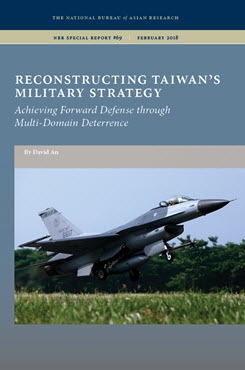NBR Special Report no. 69
Reconstructing Taiwan's Military Strategy
Achieving Forward Defense through Multi-Domain Deterrence
This report identifies the drivers of Taiwan’s military strategy and examines this strategy in the context of the threat posed to the island by the People’s Republic of China (PRC) and other key challenges.
EXECUTIVE SUMMARY
MAIN ARGUMENT
Taiwan’s military strategy consists of securing territory with resolute defense and utilizing multi-domain deterrence with joint capabilities. In pursuing these goals, Taiwan has recently begun to prioritize engaging with potential adversaries farther away from home and increasing self-reliance by developing indigenous weapons. Although Taiwan is becoming concerned about other regional security threats arising from North Korea and the South China Sea, its military strategy is still centered on the threat from the PRC and is based on three factors: the level of threat posed by China, the level of support from the U.S. and its regional security partners, and the government’s and public’s perception of the seriousness of the threat from China. Essentially, Taiwan’s defense strategy will become more aggressive if the threat level is high, expectation of U.S. support is low, and the domestic populace identifies China as a serious threat. Conversely, it will become more relaxed if the level of threat is low, U.S. support is strong, and there is little security concern among the public. Taiwan’s defense strategy will waver if there is a mix of factors, such as if the level of threat is high but U.S. support is uncertain or the public is complacent. The latter scenario most accurately describes Taiwan’s situation in recent decades.
POLICY IMPLICATIONS
- Taiwan should explore alternative models for its military strategy, particularly the assertive defense strategy and tactics of Israel today and Finland’s approach to the Soviet Union after World War II. Either of those models could be useful for managing the threat from the PRC.
- Although its military hardware is formidable, Taiwan should continue to improve military training. Increasing the realism of military exercises will help Taiwan’s troops defend against the significant growth in China’s military power.
- The U.S. should continue its support for Taiwan. Although Taiwan’s military is becoming more self-sufficient, the U.S. and its regional partners still play an indispensable role in the island’s security.


